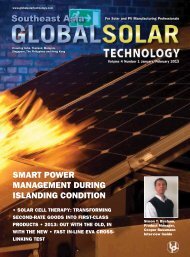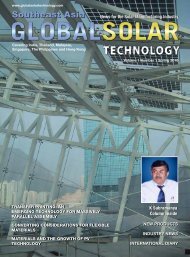Magazine SEA 3.5 Edition - Global Solar Technology
Magazine SEA 3.5 Edition - Global Solar Technology
Magazine SEA 3.5 Edition - Global Solar Technology
Create successful ePaper yourself
Turn your PDF publications into a flip-book with our unique Google optimized e-Paper software.
of San Jose, California. Panel arrays are<br />
composed of modules made up of several<br />
solar cells or photovoltaic cells that<br />
absorb sunlight that produce electricity.<br />
The larger the panel, the more electricity is<br />
produced. Electricity in the form of direct<br />
current is produced by the panels, which is<br />
not directly usable energy for a building.<br />
Most buildings require alternating current<br />
at a higher voltage. To make usable<br />
building power, the solar panel's direct<br />
current is fed into an inverter that transforms<br />
it into alternating current at a<br />
higher voltage. This alternating current<br />
power is then sent to the building's main<br />
transformers where it can be used by the<br />
building for its energy needs. "This new<br />
array along with the pre-existing array<br />
is doubling the amount of energy that is<br />
being produced for the lab. Together they<br />
are providing nearly 30 percent of the<br />
lab's annual energy needs and saving the<br />
National Guard and taxpayers' approximately<br />
$118,000 annually," said Jose Diaz,<br />
project manager, U.S. Army Corps of<br />
Engineers, New York District.<br />
This project is also tied to the public<br />
power grid so that excess energy can be<br />
shared with the public. In addition, the<br />
project is under the State of New Jersey's<br />
<strong>Solar</strong> Renewable Energy Certificate<br />
Program. Under this program, solar system<br />
owners that generate over 1,000 kilowatts<br />
of electricity per year that are connected to<br />
the public power grid receive certificates.<br />
These certificates are then publicly sold<br />
and traded to New Jersey businesses and<br />
individuals, enabling them to receive solar<br />
power benefits without building a solar<br />
power system themselves. The revenue is<br />
returned to the solar system owners.<br />
The New Jersey National Guard expects<br />
to generate anywhere from $100,000-<br />
$140,000 annually in extra income from<br />
this facility and like they've done in the<br />
past, will reinvest this money to fund<br />
other energy reducing projects at other<br />
New Jersey Army National Guard locations.<br />
Diaz said, "I enjoyed working on this<br />
project because it makes me feel a sense<br />
of pride knowing that these projects will<br />
reduce our dependency on foreign oil and<br />
will help our country to achieve energy<br />
independence, as well as the benefits to<br />
our environment. It's also great that the<br />
Department of Defense is embracing the<br />
use of renewable energy and leading the<br />
way in the use of these technologies. This<br />
was evident at a U.S. Army/US Air Force<br />
Energy Forum I recently attended where<br />
the motto was 'Power the Force. Fuel the<br />
Fight.' "<br />
Dr. JoAnne Castagna is a Public Affairs<br />
Specialist (Writer) for the U.S. Army Corps of<br />
Engineers, New York District.<br />
16 www.globalsolartechnology.com<br />
– <strong>Global</strong> <strong>Solar</strong> <strong>Technology</strong> –March/April 2012 <strong>Global</strong> <strong>Solar</strong> <strong>Technology</strong> www.globalsolartechnology.com<br />
– August/Sept 2012 – 9
















